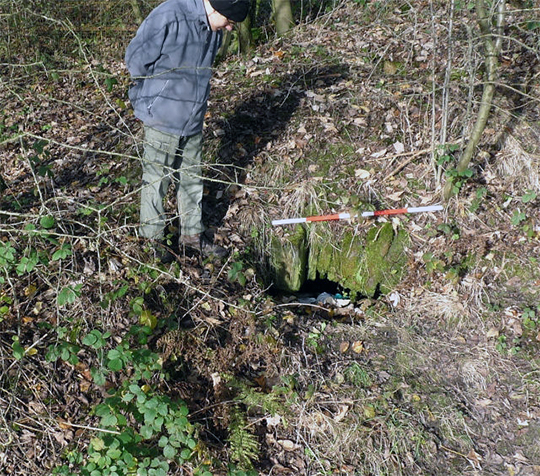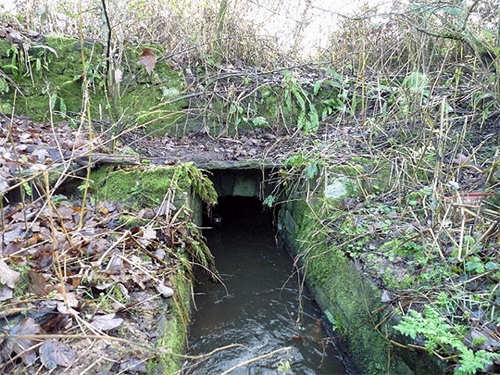
Last month we arranged a visit to this site to see if there was any potential for future work. We were first drawn here last year by Derek Winstanley (who now lives in the US). He had noticed on a recent visit that there were still visible remains of an old lime kiln marked on the 6 inch OS map of 1849. I took a look at the site last year but, as we were busy with other commitments at the time, wasn't able to spend more time on it. The site is located between Lamberhead Green and the Winstanley Hall estate. The kiln is marked on the side of Brook Lane, which is accessed behind the White Swan. After parking up at the bottom of the Brook Lane we soon spotted a stone arch protruding from the embankment at the spot where it is marked on the map.
Lime kilns of this type had an arch at the bottom, supporting the opening where the lime was extracted after it was fired. The lime in those days was used either for mortar or spreading on the fields to reduce the acidity. The raw material (limestone) is not locally available and so had to be shipped on the Douglas Navigation and brought up to the site on a colliery line.
This old line is marked on the 1849 OS map crossing Brook Lane near to where the kiln is located. The line is also shown continuing across the Pingot Valley supported on a viaduct known as The Arches. This line is famous for carrying the Yorkshire Horse - a steam engine which pre-dated Stevenson's Rocket. Its main function was to transport coal from a mine on the Winstanley estate down to the River Douglas but was also used to bring back the limestone.
It is obvious that there is not much left of the old kiln but we thought that the extent of the remains should be at least recorded. Census records also indicate that there was a small community living in this valley in the mid 19th century in various cottages (nine households with a total of forty-six people). Also marked on the map is the Pingot Well. It is said to have been the only decent supply of water in the Pemberton area and there was a near riot when the council closed it 1880 (for more details visit WiganMan's website).

With this in mind we extended our search to the undergrowth opposite the kiln on the other side of the lane. This was to see if we could spot any remains of the viaduct or buildings relating to the old community that once lived there. Stonework showed up on the same alignment as the viaduct, appearing where the Smithy Brook enters a short culvert. There were also large lumps of masonry lying about and evidence of a low wall where perhaps the old Pingot Well used to be.
Our trip proved that this site does have good potential and worth setting up a project to see if we can identify and record some of the features, some of which are likely to date back to the mid 18th century.
Next Meeting
Wednesday 5th December - in the Standish Suite at the Brocket Arms (7.30pm as usual).
This month we have our old friend John Johnson from the Horus Egyptology Society who will be telling us about the latest developments on the West Bank at Luxor and particularly the excavations at the mortuary temple of Amenhotep III. The only evidence for this temple are the two huge statues entitled Colossi of Memnon. It turns out however that this temple was enormous, even bigger than Karnak itself.
It disappeared quite early on, probably because it was mainly made of mud brick and the constant inundations of the Nile caused it to deteriorate quickly. Any stonework left was robbed by later pharaohs to build their own temples. The statues were reused with the names of the new owners chiselled on (even the massive granite statue of Rameses in the Ramesseum was originally Amenhotep's). Excavations by German archaeologists over the past 40 years have uncovered more and more information from this site. They are gradually piecing together evidence to show that this pharaoh was probably the greatest ever builder in the Nile Valley (not just at Luxor but for the whole of Egypt). Sounds like a great talk. - hope to see you there, BA (by the way as it's our last one before Christmas the will be the usual festive refreshments on hand).
|



